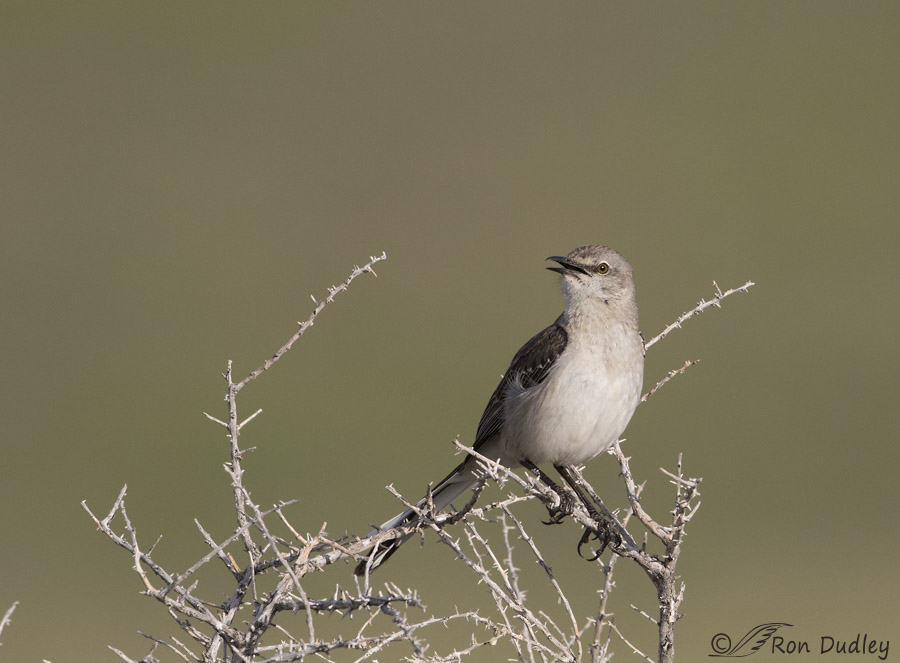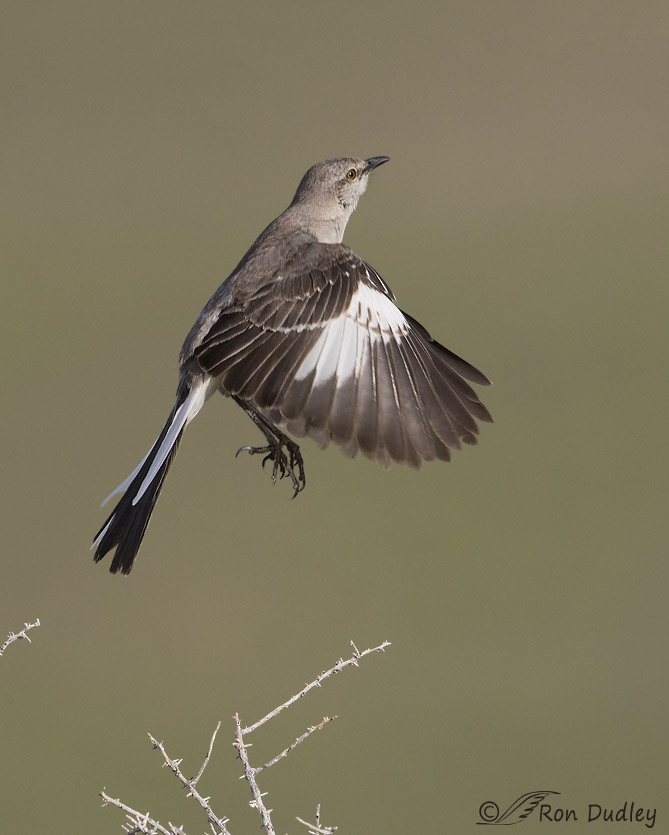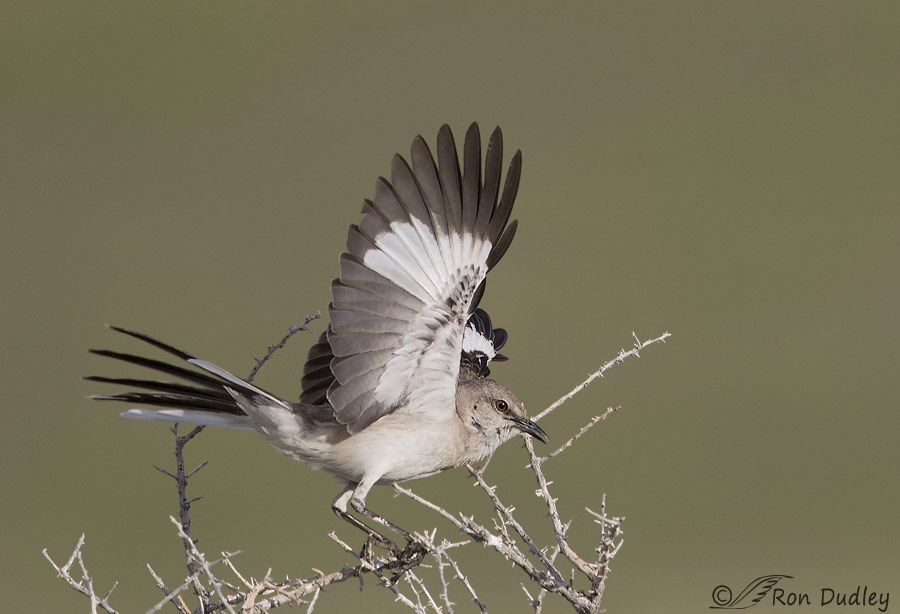This “flight display” is one of three courtship displays known to Northern Mockingbirds.

1/4000, f/6.3, ISO 800, Canon 7D Mark II, Canon EF500mm f/4L IS II USM +1.4 tc, not baited, set up or called in
I photographed this one yesterday morning on Antelope Island. The display, performed by males, usually begins with the bird singing high on a perch.

1/3200, f/6.3, ISO 800, Canon 7D Mark II, Canon EF500mm f/4L IS II USM +1.4 tc, not baited, set up or called in
Then he jumps 6 to 8 ft almost straight up above the perch as he flaps his wings a time or two. During the process his white wing patches are conspicuously displayed and he sings almost continuously although I caught the beak closed in this shot. Then with his wings out he parachutes almost straight down onto the same or a nearby perch.

1/2500, f/6.3, ISO 800, Canon 7D Mark II, Canon EF500mm f/4L IS II USM +1.4 tc, not baited, set up or called in
This time I lost focus on him as he parachuted down but reacquired it just as he landed again on the same perch.
I’ve been trying to photograph this behavior all spring without much luck and I think I may know part of the reason why. This display is rarely if ever performed when all or most of the males in a population are on a breeding territory they’ve used in previous years. But when new males are residing on some of the territories the display is common.
Perhaps most of the males on the northern part of the island this year are old-timers on territories they’ve used before. Either way there’s no question that I’m seeing the behavior less often than I did last spring and early summer.
Northern Mockingbirds were once thought to be headed for extinction due to the caged-bird trade in the 1700s and 1800s but since that time they have largely recovered. They’re very common in some parts of North America but much less so in my area, although I’m seeing more of them than I used to.
Ron
Note – A word of warning to those planning a trip to Antelope Island in the near future. Most years the biting gnats are a much bigger nuisance than mosquitos but this year seems to be an anomaly. For the last week or so the skeeters have been absolutely horrific! – worse by far than I’ve ever seen them on the island. We’re now paying the price for our unusually wet spring.
Come prepared…


This display is one I love to watch. We are blessed with a lot of mockingbirds here in Austin. I had a bachelor outside my window one summer. Can’t tell you how glad I was when he finally found a mate. SHUT UP BIRD. If I’d had a way of importing a single female, I think I would have.
If I’d had a way of importing a single female, I think I would have. 
Great shots of one of my favorite birds. Love the 3rd pic.
Thank you, Jean.
Wow, wow and wow.
Human choreographers and athletes need to slink away in shame. As do the operatic divas.
I am very glad that I can view your posts from a bug-free zone. The bitey beasts LOVE me to the extent that the smaller portion insists I come out with him when he is in a skeeter zone so I get bitten and he doesn’t.
“the smaller portion insists I come out with him when he is in a skeeter zone so I get bitten and he doesn’t.”
There must be some extra “sweetness” in your blood, EC. Care to ride around with us while we’re shooting?…
Ron, as always beautiful photographs. We live in the Phoenix area & have a bird that I have been told is a Mocking Bird. It does look similar to these photos. Do you know what kind of mocking bird we might have here. And d you have any photos of them?
Thanks
David
David, The only mockingbird in your area would be this one, the Northern Mockingbird. The only other mockingbird in N.A. to my knowledge is the Bahama Mockingbird and you’re not in their range.
Beautifully detailed shots Ron! Thanks for sharing!
Charlotte
Thank you, Charlotte.
Ron, we don’t see them in MI unless we go south or west. Thanks for reminding me of time spent listening to them calling most of the night in spring. Great photos. Great bird acrobatics.
Diana, As I’m sure you’re aware their mimicking repertoire is amazing. Some mockingbirds learn up to 200 different songs, many of which are those of other species. In the field it blows me away sometimes to hear an obvious meadowlark or shrike nearby when closer investigation reveals it to be a mockingbird just doing its thing…
Thanks Ron! I have often wondered why I do not see Northern Mockingbirds more than I think I should. Now I know! This behavior must be awesome to see in person! Thanks for sharing your photos and knowledge!
“This behavior must be awesome to see in person”.
It certainly is, Nancy. It isn’t easy to photograph though, partly because they nearly always seem to have their back to me in the air and it’s so easy to lose focus on them in flight.
Beautiful shots, and I love the look of whatever he’s perching on. I’ve never lived any place that didn’t have mockingbirds, so I had no idea that they’d ever had any problems. I’ve always enjoyed their singing and their attitude.
Susan, Just a few years ago I almost never saw mockingbirds around here but lately their numbers seem to be increasing. I think they’re very interesting birds for a variety of reasons.